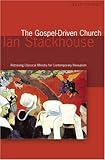 So I have finally finished my look into the emerging church. I’m sure there is a lot more that could be said, and a lot of other people who could have explained it much better. I notice that Scot McKnight has recently done just that in an article called the 5 streams of emerging church. His headings are Prophetic, Postmodern, Praxis-oriented (Worship, Ortho-Praxy, Missional), Post-evangelical (Post-Systematic Theology, In Versus Out), Political.
So I have finally finished my look into the emerging church. I’m sure there is a lot more that could be said, and a lot of other people who could have explained it much better. I notice that Scot McKnight has recently done just that in an article called the 5 streams of emerging church. His headings are Prophetic, Postmodern, Praxis-oriented (Worship, Ortho-Praxy, Missional), Post-evangelical (Post-Systematic Theology, In Versus Out), Political.
It was quite encouraging to see that I had covered much of the same ground, despite having not read any Brian MacLaren or other emerging books. All this has been picked up from reading blogs, listening to emerging sermons and the occasional visit to an emerging church meeting.
Here’s an index of my posts on this subject:
- Introduction
- Part 1 – Postmodernism
- Part 2 – Being Missional
- Part 3 – Authenticity
- Part 4 – Scripture
- Part 5 – Ancient Future
- Part 6 – Doctrinal Distinctives
- Part 7 – Politics
Conclusions
So what are my conclusions? To be honest, I will be glad to take a break from this subject for a while. Though the church is important, it is possible to be so preoccupied with ourselves that we can take our eyes off God. But despite my reservations about the emerging church, there are some lessons to be learned. Personally, I hope that, rather than evangelical churches going “emerging”, we receive their criticism where it is justified, and reform ourselves to be more faithful to Scripture.
So I will round off this series with a few things that the emerging church needs to teach us…
- We do need to learn how to engage with our culture better so we can communicate the gospel.
- Lack of humility and integrity from leaders is devastating to the witness of the church. We need to remember that leadership is as much about character as it is charisma (if not more so).
- We need to recover a deeper appreciation for Scripture, that recognises its unity as a meta-narrative, rather than just a rule-book or doctrine handbook. Many charismatic churches need to get back to reading it more, rather than merely proof-texting from it.
- We need to demonstrate a real concern for justice that is outworked in practical action, including (but not limited to) getting involved in politics
- We need to learn to appreciate the wisdom of believers from past centuries. Though they may have got many things wrong, we should not be too proud to think that they have nothing to teach us. Charismatics in particular need to believe that the Holy Spirit really was at work before the 1900s.
… and a few things that we would do well to avoid…
- We must not let the world dictate our agenda and morals. The gospel will always seem offensive and foolish to some, however graciously we try to present it. The emerging church is right to seek to forge good relations with secular community leaders, but we cannot compromise on truth to earn their favour.
- Heresy is a real danger to the church. Whilst we should allow for differences of opinion over debatable matters, the New Testament is brimming with warnings of false teaching. Many emerging people congratulate each other for having “different answers” to a question, when in fact they should be lovingly challenging one another.
- We should not give up meeting together. In some (but certainly not all) parts of the emerging movement, Christians are no longer part of any church, and those that are are meeting for worship only very rarely.
- We should not set up a false dilemma with respect to what holiness looks like. ie. the old paradigm of sexual purity, sobriety, daily devotions etc should not be rejected to be replaced new paradigm holiness – ethical consumerism, environmentalism etc. Rather, we should recognise that holiness has both negative (sins to avoid) and positive (good works to do) aspects and pursue both with equal vigour.

